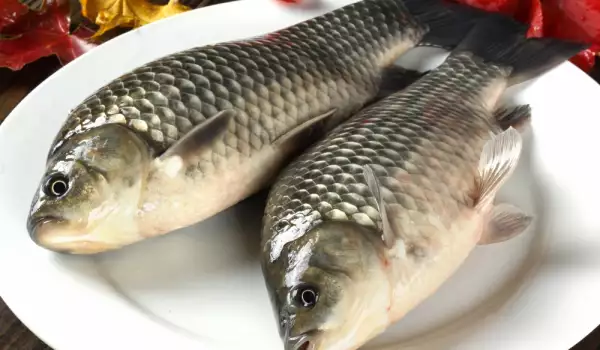Carp (Cyprinus carpio) is one of the most popular fish in the world, which even managed to put down deep roots in many traditions and beliefs. Besides the feast of Saint Nicholas, the fish is a tribute to many round tables.
Carp is flattened laterally, characterized by high backs and relatively small heads. Generally, there are three types of carp - scaly carp, whose body is covered with scales, mirror carp, which has larger scales arranged in three rows and naked carp, with no flakes.
It is a freshwater fish that is highly adaptable and resistant to changes in habitat. That is why today it is one of the most commonly harvested fish in the world. After 500 years of selection, today there are many subspecies of carp.
Average weight of carp reaches 30 to 35 kg, but the best are those from 800 g to 3 kg. World record for the largest carp caught is held by Austrian fisherman Christian Baldeman, who captured a giant carp weighing 37.3 kg and with a length of 115 cm.
Carp reaches sexual maturity at between four and six years in warmer areas and in cooler conditions can be propagated at 3-4 years of age. In three years the carp can reach 35 cm and weighing about 1 to 1, 250 kg.
Although this species is distinguished by being more productive - about 180, 000 grains of caviar on 1 kg live weight, very few of them survive because they are eaten by many other aquatic life forms - both the carp eggs and the small babies. Spawning of carp occurs in May-June, between stones and water plants.

Carp is one of the most widespread species of fish in the world, and is spread throughout many ponds. Due to problems with the destruction of eggs, improper fishing policy and bad faith of fishermen, every year the population of carp decreases more and more.
Conditions for its reproduction actually prove difficult or even impossible.
Carp bite best on corn bait. If you fish for carp in the summer, you know that most fish are caught best at night, or in the morning. On a dark and cloudy day, carp also bite wel - during or after rain. Perhaps the most successful is the catch during spring and autumn, when the fish bite all day.
Light and delicious tradition of St. Nicholas dictates that you eat grilled, stuffed or fried carp, it is bound with an interesting legend. Once, when St. Nicholas went with a boat in the sea, a terrible storm arose, which punctured his boat. To save the boat, himself and his companions, the saint caught a carp and plugged the crack successfully.
From then on St. Nicholas traditionally carries a sacrifice of fish, mostly carp because carp is considered a servant of Saint Nicholas. The most common of the Day is prepared ribnik - carp wrapped in dough. After the traditional meal of St. Nicholas, the bones of the carp are not discarded.
They should be burned, buried or put in a river. Belief says that welfare and fertility in the family will increase.
Traditionally, older women sew hats of the children from the skull bone of a carp, which is in the shape of a cross. This is done to protect them from evil spirits and bad luck. In China and Japan, traditional beliefs require that when a boy is born, it is destined to grow up healthy, strong and smart, with the help of carp.
History of Carp
The first carp came to Europe from Asia in ancient Rome. At the time, carp was considered an eccentric culinary delicacy. Further in history, in the Middle Ages, the Catholic Church pulled the fish from their meat list. Thus, monks began to breed carp in ponds to have food for the many fasting days on the calendar.
The best breeders of fat carp proved Bohemian monks in the Czech Republic. Gradually there were distinct new species of carp that had a growing culinary value or, in other words, easily prepared and tasty. Even today, the Czech Republic continues to be the world's largest exporter of live carp.
Composition of Carp
Carp is quite an oily fish, but that also depends on the circumstances and the place in which it is grown. Like most fish, carp is a valuable source of unsaturated Omega-3 fatty acids, protein and various trace elements, such as phosphorus.

100 g of carp contains:
Calories: 127 Kcal
Calories from fat: 50.4 Kcal
Fat: 5.6 g
Saturated Fat: 1.1 g
omega-3 fatty acids : 0.6 g
Cholesterol: 66 mg
Protein: 17.8 g
Calcium 41 mg
Potassium 332 mg
phosphorus 415 mg
Culinary use of carp
The best carp for filling is up to about 3 kg and battering is done on smaller specimens. Tasty carp meat is tender, creamy with a solid structure and very juicy and tasty. Carp is considered most delicious in late summer and autumn, when the fish have accumulated enough fat for the winter months. It is best to prepare very fresh carp.
Choppped carp up to 1.5 kg may be best for frying and battering. They show no further splitting of their spine length, as is done in larger fish. Above all, carp should be well washed and scales cleaned up. They can be easily scraped if you leave the fish in boiling water for 2-3 minutes. Then you can cut the tail, removing the entrails and gills. Finally, the carp is again washed and drained before starting to cook.
Carp makes for some very tasty fish broths. Besides the actual carp, its caviar has culinary value, when salt-cured and it is considered some of the best caviar. Often, as a substitute for carp, you can use other fish. The taste of carp fits very well with Riesling wine.






















